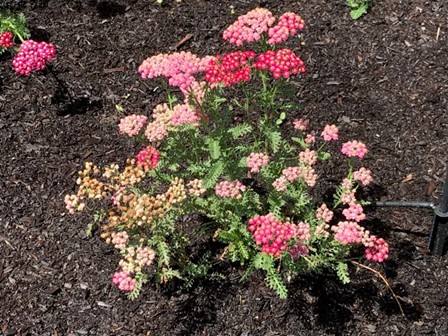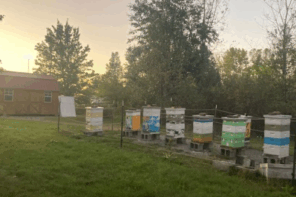Alyssum Flowers
An interesting plant to add texture and detail to any garden is Yarrow, Achillea species, also known as Devil’s Nettle, Dog Daisy, Dog Fennel, Milfoil and Soldier’s Woundwort, to name a few. Introduced to the United States from Europe by early colonists, this perennial was used for many health benefits and was a must for those immigrating to a new world. Early records showed that the entire plant was used, either fresh or dried in tea, as a poultice or crushed for burns, to stop the flow of blood, help reduce stomach pains, alleviate kidney ailments and reduce fevers and colds. Named after the Greek hero, Achilles, it was used to heal soldiers’ wounds and prevent infection. A leaf applied to a bad tooth would reduce the pain, as it contains the anti-inflammatory chemical, azulene. Note though, that some people develop a skin sensitivity to the leaves if handled too much, and pets should not be allowed to eat the plants. As with any medicinal product, one should consult their doctor before using it.
Yarrow has flower heads about two to four inches across and look similar to Queen Anne’s Lace but are tighter. They arise from branched stems near the top of the plant with each flower cluster comprised of smaller flowers, forming an umbel. They are favored by many butterfly species as well as bees and other pollinators. Leaves emerge from a central stem and are long and finely divided (much more so than Queen Anne’s lace), technically termed pinnatifid. In the Spring, yarrow produces basal fern-like leaves then as the stem elongates, each tier of leaves are slightly shorter, so that the mature plant is slightly tapered, averaging one to three feet. This tough and easy to grow perennial can flower from April through October if it receives full or mostly full sun.
The wild yarrow, A. millefolium has white florets and grows well in wildflower plots, perennial gardens or in open sunny areas, in almost any soil type. Although it prefers well drained soil, it will tolerate dry and wet conditions and is tolerant of poor soil. For a more compact growth habit, cut the spent flower heads directly above a lateral branch. In open plantings, they can be mowed at the highest setting in late Fall after all the flowers have formed seed heads The flowers can be cut and placed in water for fresh floral decor or dried for later use. The pungent leaves keep their form and add a soft sculptured look in wreaths, potpourri or vase arrangements.
Cultivated varieties include ‘Sassy Summer Sunset’ and ‘Sassy Summer Sangria’ (grown at A.I. Root) with orange or pinkish flowers, ‘Coronation Gold’ a brilliant yellow cultivar and A. tomentose, called Woolly Yarrow, a dwarf cultivar, reaching six to eight inches tall with gray, fuzzy leaves.
Tough and deer repellent, yarrow is easy to grow with few problems. The rhizomatous roots allow the plant to form dense patches which can be divided in Spring and Fall. It freely self seeds and is a beautiful fragrant addition to any landscape. Although the wild species can look straggly in the Fall, it can be mowed to three inches tall to provide cover for caterpillars and other small insects and provide some soil protection. Cultivated varieties have a denser canopy and are very attractive in a flower bed. Hardy from zone three to nine, it would enhance any landscape. Plan to add it to your plant scene this season.
References:
https://www.missouribotanicalgarden.org/PlantFinder/PlantFinderDetails.aspx?taxonid=277129
https://www.fs.usda.gov/wildflowers/plant-of-the-week/achillea_millefolium.shtml
https://www.illinoiswildflowers.info/weeds/plants/yarrow.htm














